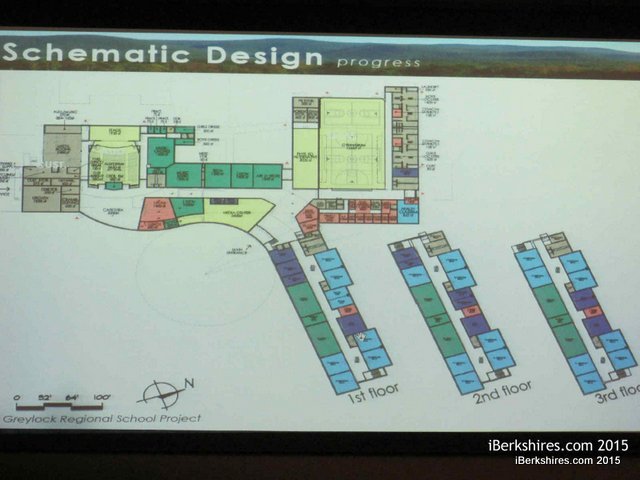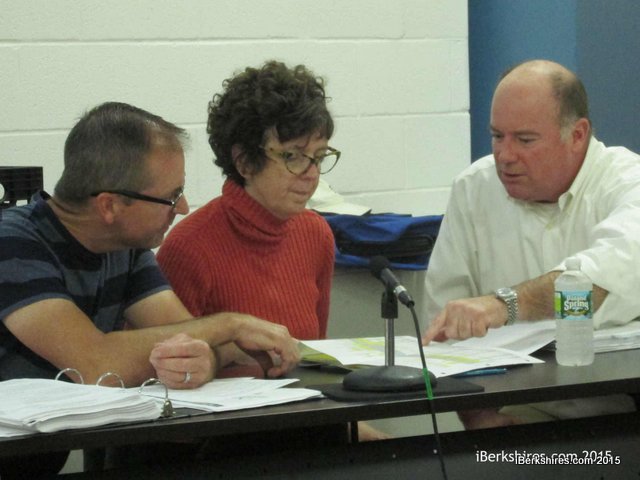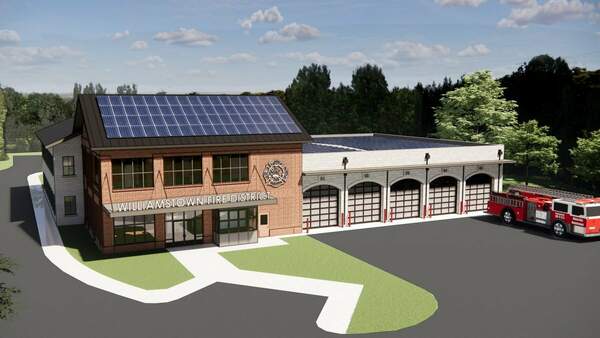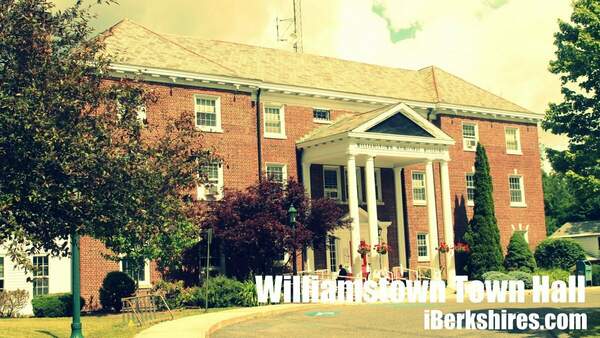
Mount Greylock Building Committee Makes HVAC Decision
 Mount Greylock Owners Project Manager Trip Elmore of Dore & Whittier, right, consults with district business manager Nancy Rauscher and facilities supervisor Jesse Wirtes before Thursday's meeting. Mount Greylock Owners Project Manager Trip Elmore of Dore & Whittier, right, consults with district business manager Nancy Rauscher and facilities supervisor Jesse Wirtes before Thursday's meeting. |
WILLIAMSTOWN, Mass. — The Mount Greylock School Building Committee on Thursday directed its architects to plan for a few zones of air-conditioning in the renovated junior-senior high school.
The committee spent its second straight meeting looking at options for heating, venting and air-conditioning systems for the addition/renovation project being designed by Design Partnership of Cambridge.
As the committee discussed at its Sept. 3 meeting, it had little interest in air-conditioning the planned new three-story academic wing, but there were several places in the public wing where committee members think air-conditioning will add to the building's functionality.
One spot is the administrative offices, which are used 12 months per year. The the committee's facilities working group recommended that the nearby media center (what would in the past have been called a library) also be cooled.
School Committee Chairwoman Carolyn Greene, a member of the building committee, asked whether it would be more cost effective to do one without the other. But HVAC consultant Michael Walsh of Canton's Consulting Engineering Services and Mount Greylock Principal Mary MacDonald made the case for doing the media center as well.
"Often I see the media center being the most used space in the summer," Walsh said, referring to other school projects on which he has been involved.
MacDonald said she foresees the space being well used for summer-based meeting and professional development for the Mount Greylock faculty during the summer months.
And, Walsh said, the initial cost of adding cooling capacity to the media center was about $100,000.
The other two areas that are currently slated to receive air-conditioning are the renovated auditorium and new cafeteria.
The new cafeteria is planned to be located on the east side of the building, with views of Mount Greylock and directly across the hall from the main entrance of the current auditorium.
Both the cafeteria and auditorium can fill up with people in late summer and late spring and become uncomfortably warm — even on days when it is not especially hot outside, Walsh's colleague Sal Fazzino told the committee.
Fazzino explained that by linking the cafeteria and auditorium, the cooling system can be designed for maximum efficiency.
Again, Greene asked whether it would be more cost effective to cool just the cafeteria, and she argued that, in her experience, auditoriums are commonly "over air-conditioned."
Fazzino said if the committee decides to cool the cafeteria, the cost of adding the auditorium is "marginal," and both Fazzino and Walsh sought to allay Greene's fears of over cooling the auditorium.
"These are high performance type systems we're providing," Fazzino said.
The air-conditioning will respond to the occupancy of the room and ratchet down when it is not filled, the consultants said. On the other hand, Walsh said, a full auditorium on a hot day can get very uncomfortable without air-conditioning.
"I'm fine if it really is that sensitive and you're not going to be freezing," Greene said.
Other than the cafeteria, auditorium, administration and media center, the bulk of the building (save a few computer labs) will be heated, ventilated and dehumidified under the current design.
That does not mean that the classrooms themselves will be oppressively warm on hot September or June days, Walsh said.
"On that worst-case day, when it's 88 or 90 degrees ... we'll control the humidity, keeping 50 to 60 percent humidity, but there's a good chance the temperature in the classroom will reach into the high 70s, maybe even 80," he said. "For the sake of this conversation, we have to assume high 70s, maybe 80, but with a comfortable humidity."
By not air-conditioning the academic wing, the School Building Committee was able to shave an estimated $1.2 million off the initial $57 million estimate for the addition/renovation project.
Cost savings were again high on the committee's list of priorities.
Another decision it's made is to scale back from the initial concept of having a sink in every classroom. Other than the labs, the art room and a couple of other locations — like the special education department's life skills classroom — the committee did not see the need. And the cut took an estimated $275,000 out of the project's bottom line, owner's project manager Trip Elmore told the committee on Thursday.
"These are all estimates and, in some cases, estimates on estimates," Elmore cautioned. "But we're doing whatever we can to get that number down from $57 million."
The day is fast approaching when the committee will be dealing in final numbers instead of estimates. Assuming the Massachusetts School Building Authority board votes on Sept. 30 to advance the Mount Greylock project, the district will have until Dec. 1 to send a final project — and budget — to MSBA.
With that in mind, the School Building Committee had a typically ambitious agenda on Thursday.
Other business included a discussion of whether the district should consider applying for a National Grid green rebate program, an update on the it's progress in naming a construction manager "at risk," consideration of a proposal to do geo-environmental work on the school's grounds and an initial conversation about exterior envelope materials.
The last discussion was tabled since the designers have just begun discussions with the materials working group. But architect Bob Bell of Design Partnerships did share the most recent evolution of the building's layout.
One major change: the relocation of a stairway to the end of the academic wing.
The change allows for a windowed stairwell that takes advantage of views to the northeast side of the property, and it responds to a concern expressed by the MSBA, Bell said.
"We heard comments from MSBA about the potential for an addition [to the wing]," Bell said. "Each end window would be sized so a doorway could go there."
Another change from previous iterations of the layout: the design currently has the media center located on the east side of the building where it, like the cafeteria, will take advantage of the view and where it will have more of a position of prominence. That change necessitated moving the administrative offices from their position in past designs.
"The media center has prime real estate," Bell said.
The architects also are refining the project's academic wing. It has evolved from the initial shoebox layout to instead "bump out" Some classrooms, creating enlarged corridors that can be used as the informal learning spaces the committee long has envisioned.
"We think we have the pieces a little better evolved, but as we have conversations with user groups, we have places we need to go back and reexamine and reproportion," Bell said. "We think we can reduce the square footage a little further. We're going to try to reduce by 1,000 square feet without affecting programming."
Tags: MGRHS, MSBA, school project,

 WILLIAMSTOWN, Mass. — The Prudential Committee on Wednesday signed off on more than $1 million in cost cutting measures for the planned Main Street fire station.
WILLIAMSTOWN, Mass. — The Prudential Committee on Wednesday signed off on more than $1 million in cost cutting measures for the planned Main Street fire station.













